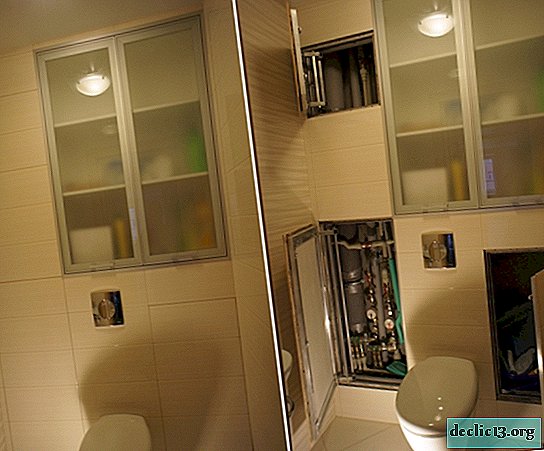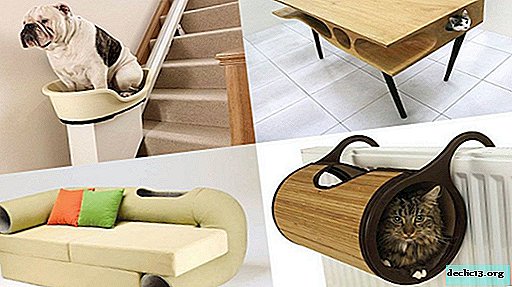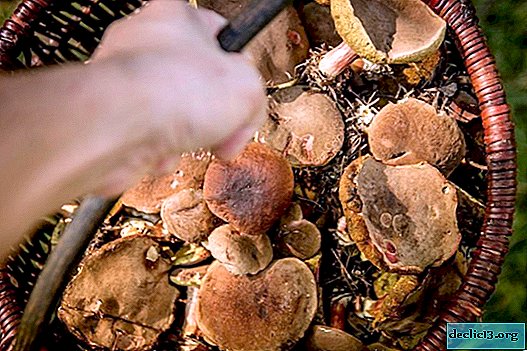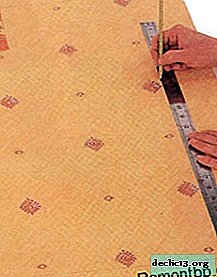Advantages of independent restoration of a chair, work procedure
Throwing out furniture that is quite suitable for further use due to worn upholstery and squeezed filler is an unjustifiable waste. The old "grandmother's" chair, dusting for years in the country, may well get a new life, especially if the frame of the product is still strong. Any model of this type of upholstered furniture, the reliability and convenience of which has been tested over the years of operation, can be updated globally or in fragments. Often, the restoration of a chair becomes a salvation if the once favorite product ceases to fit into the interior for a number of reasons. It is possible to carry out furniture upholstery, replace springs, repair armrests and seats independently, without involving professional masters in the process. The tool necessary for work is found in every house, you only need to first study the procedure for restoration.
Benefits of self-updating
Do-it-yourself furniture repair is not really as complicated as it seems. If you have sufficient skills, and with each step they will be acquired, accumulated and improved, even a beginner in this business will be able to upgrade a chair at home. According to experts, the main thing here is to act carefully and not deviate from the plan - in this case, the final result will impress the household. In addition, the self-constriction of furniture has an undeniable advantage - it will cost much cheaper than contacting professionals or buying a new product. And if you show a little imagination and creativity and think ahead of time how to do it yourself with your own hands to update the old chair, changing the design that has lost its trend or improving the shape, you can turn it into a completely new element of the situation.
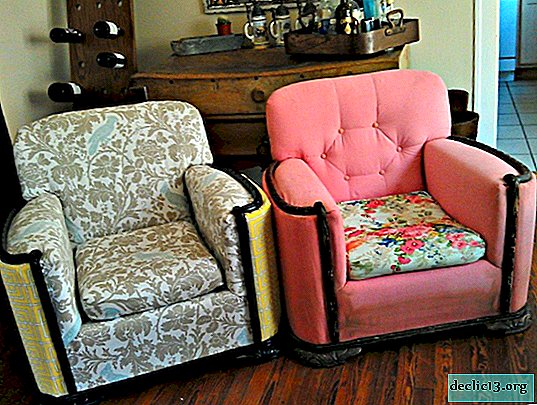


Instruments
Restoration of armchairs with your own hands is impossible without a specific set of tools, as a rule, available in the arsenal of each home master. Necessarily required:
- hammer;
- flat-head and cross-head screwdrivers;
- tailor's scissors;
- adjustable wrench;
- pliers;
- metal and hair brushes;
- furniture or construction stapler with staples not less than 10 mm high;
- screwdriver;
- clamps;
- tape measure or tailor's centimeter - measuring tape 150 cm long;
- sandpaper, fineness from P40 to P120.
In addition to tools, the restoration of an old chair will require a suitable fabric to cover. Additionally, depending on the condition of the wooden frame and old springs or pillows, materials may be needed to restore or replace them:
- foam in plates or sheets;
- batting;
- joiner's glue;
- furniture varnish;
- paint, primer;
- self-tapping screws.
Instead of wood glue or wood glue, you can use thick PVA for paper and cardboard.



Work order
Before undertaking the restoration of a chair with your own hands, you need to carefully examine it in order to know in advance what actions and in what order to be performed. During the inspection, it is necessary to assess the condition of the upholstery, the wooden structure that serves as the frame, as well as the lifting mechanisms, if the chair is folding, and the seat is equipped with them. Upholstery, as a rule, is replaced by a new one, wooden shattered parts are strengthened with glue. But it happens that the mechanisms are worn out, and the seat cushion does not rise, what to do with this problem will depend on the specific situation. It is unlikely that it will be possible to fix worn metal parts, and replacing mechanisms with new ones can be unreasonably expensive. Alternatively, you can abandon them altogether and, having sacrificed functionality, fix the pillow motionless. If you determine in advance the scope of work and carefully consider how to repair a chair, you can end up with really comfortable upholstered furniture.
Disassembly and preparation
Any disassembly of chairs and upholstered furniture should begin with the dismantling of the upholstery. All actions must be performed extremely carefully, trying not to damage the integrity of the tissue.
Elements of the old coating are very convenient to use as patterns for future patterns of new casing, which will save a lot of time and labor when repairing a chair with your own hands.
If the restored model is equipped with armrests and decorative details, they are also dismantled. But in some cases, you will first need to remove the seat cushions and backs, if they are provided for by design.
A base repair may be required. Often, metal springs, which were standardly installed inside in Soviet furniture samples, are unsuitable for further use, breaking completely or sifting over time and losing their former elasticity and stiffness. In this case, the wooden frame can be covered with jute tape. Step by step, it looks like this:
- first, the product is pulled in one direction, for example, from left to right, and then in the other, perpendicular - from bottom to top;
- tapes of opposite directions need to be interwoven with each other, and their ends fixed on the frame with a stapler.
As a result, instead of a cushion, old spring mechanisms will produce a strong fabric base for the new seat.
When examining a wooden frame, you need to pay attention to the strength of the parts and their connections to each other. You may need to disassemble some nodes to glue the joints again. If you have to perform a restoration of a chair with wooden armrests and legs, you must decide whether to change their finish.
 Dismantling the chair
Dismantling the chair Jute banner
Jute bannerDesign update
Serious enough repairs will be needed if the frame is loose or, even worse, some elements burst along - this happens due to long-term storage of furniture in unheated rooms, where the temperature and humidity values change several times a year. Having disassembled the nodes, you need to inspect the details in order to assess the possibility of their further use. Typically, the joints of wooden structural elements are tightly spike-in-groove. If the chair has been stuck for a long time, surface swinging could occur during rocking. In this case, the gaps between the parts increased, and the joints in the assembly became more mobile than during the initial assembly. Simple gluing in this case will give a short result - soon the structure will loosen again, so you will need to get rid of the gaps by inserting wooden planks of appropriate sizes.
All assembly parts, including new inserts, must be carefully coated with glue during assembly.
Bursting frame elements must be glued. If the part has split lengthwise into two parts, it is not difficult to do this - you need to clean the surfaces of dust and, spreading with glue, tightly squeeze it while it dries or polymerizes. To ensure high pressure, clamps or a rubber band can be used. If the bursting element does not separate, the glue can be pressed into the slot with the help of a medical syringe with a thick needle, after opening the crack with a flat screwdriver.
If the long part bursts transversely, the adhesive joint at the break point will be fragile. In this case, you can try to repair it using two patch strips of suitable length, glued along. If this is not possible due to the design features of the chair, you will have to replace the broken element. In most cases, the frame parts are straight rails and bars - it will be easy to plan them yourself.
 Glue bursting elements
Glue bursting elements Build butt surfaces to restore structural integrity
Build butt surfaces to restore structural integritySoft part update
The seat cushion and backrest are usually covered with the same material. When choosing it, the features of the interior of the room in which the furniture will be located are taken into account. For the living room or hallway, the seat and backrest are usually restored with artificial or genuine leather or jacquard - this upholstery will give the chair an expressive appearance. For rooms where an increased risk of pollution is possible, flock is most often used.
Before the very constriction you will need to perform a series of preparatory actions. If the old springs on the seat have not been removed, it will be enough to replace the soft lining under the coating material, batting folded in several layers is quite suitable. It should not be laid directly on the spring block, first you need to make a gasket from a durable material, such as burlap.
If the springs are replaced with a jute strip, as described above, it is also necessary to cover such "weaving" with canvas or burlap, and cut a foam rubber part to the size of the pillow. If the thickness of the sheets is insufficient, it is worth making the liner multilayer. Foam is covered with batting sheets, attached to the frame using a furniture stapler.
To determine the amount of material needed to restore the chair, the patterns (old coating) are laid out as compactly as possible, but no closer than 3-5 cm from each other.
When using foam inserts, the seat volume can increase, and more material will be needed for the waist - in this case, when laying out the patterns, you must also take into account the size of the allowance.
To make patterns of upholstery parts, a piece of new material needs to be laid out exactly on a flat surface, placing all the patterns on top of it. Further, all future details are outlined in chalk, and then cut out. It is recommended to overcast the edges with a sewing machine so that they do not open.
Pull the material on the pillows carefully, avoiding the formation of folds. To do this, first he "baits" at the corners of the frame with a stapler. If the pillow is round, you can mentally draw two lines through the center, imagine the intersection point and fix the fabric in it. Further, between the fixed points with a slight tightness, the edges of the upholstery are fixed. If necessary, you can remove the staples that originally "baited" the material with pliers. And then, pulling up the fabric, fasten it again.
Material on the underside of the seat and the back of the back is hemmed with thread or lined with furniture nails with decorative caps. You can fix the fabric with a stapler, and close the staples with textile decorative tape.
 Cut seat and backrest from foam rubber
Cut seat and backrest from foam rubber Cut corners
Cut corners Sew a new filler to the old layer of foam
Sew a new filler to the old layer of foam Cover the seat with new material.
Cover the seat with new material. Fasten upholstery with a construction stapler
Fasten upholstery with a construction staplerUpdate wood elements
It happens that the restoration of the chair with your own hands is not limited to replacing the upholstery and pillow filler. Often furniture provides for antique carved armrests, backrest frames, elaborate legs - you can preserve and emphasize all this beauty by updating the appearance of the elements:
- First you need to remove the old paintwork from all wooden surfaces. If the parts are flat, this can be done by using a grinding machine (tape or vibrating). If they are of complex shape, and even with carvings, you will have to peel off the coating manually using fine sandpaper. Alternatively, special formulations can be used to remove paint coatings.
- Getting rid of the old layer, you need to inspect the surface for chips, cracks, if necessary, putty them with a special composition or wipe with a mixture of wood glue with fine sawdust obtained by grinding.
- After filling the chair you will need another grinding.
- You can decorate wooden furniture elements with various paints, having previously primed the surface with special compounds and sanded it with fine (P100-P120) emery paper.
- Paint coatings are applied in several layers. Their quantity, as well as drying time, are usually recommended by the manufacturer.
A beautiful wood finish is obtained using at least 3 layers of furniture varnish. It is not necessary to prime the surface before applying it. After drying of the first layer, the surface is ground.
To preserve the natural texture and color of wood, you can not cover wooden products with paints and varnishes, but use stains.
 Sand the parts, remove the varnish
Sand the parts, remove the varnish Cover with stain, wait for it to dry completely
Cover with stain, wait for it to dry completely Treated with furniture varnish
Treated with furniture varnish Connect all the details.
Connect all the details.Assembly assembly
When the restoration of the chair is completed, the furniture is assembled in the reverse order of its disassembly. Pillows, armrests are installed on the frame and secured using the method used before dismantling. Old screws, if fasteners were carried out with their help, it is better to replace with new ones. Lastly, decorative elements are mounted.
An old armchair, repaired by yourself in accordance with the instructions given above, will certainly become a decoration in the house and the pride of the owner.
 Restored chair
Restored chair











